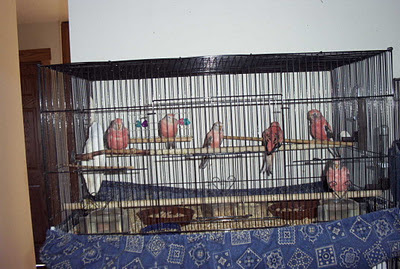 |
| Fuchsia and Flame's two youngest. |
I blame it on the holidays … smile. I’ve not been hand feeding these baby Bourkes as often as proposed.
When you’re feeding babies 100% of the time you can’t be inattentive. When the parent birds are also responsible for feeding their young, it’s easy to put it off and let them take care of it.
Of the six baby birds that I expected to hand feed twice a day, but not take over the entire feeding process, I’m now down to feeding two.
Rosie’s babies are older than Fuchsia’s. Rosie’s oldest refused to eat from an eyedropper and his sibling ate only a little. It was all too easy to choose to give up and quit feeding those two.
Fuchsia has four in this clutch. Although younger than Rosie’s, her two oldest weren’t happy about being offered an eyedropper either. I’m certain that if taken away from their parents, when hungry they’d eat the Exact Hand Feeding Formula with gusto. But, they weren’t hungry and resisted.
 |
| Baby in the butter dish is an older sibling. |
The two youngest, however, have been more willing to eat it. One seems to particularly like it. I expect the four oldest baby Bourkes to be tamer because they’ve been handled a lot, but not as tame as the two youngest. I’m hopeful that, as adults, these two youngsters will be just as tame as those that were hand fed exclusively for the remaining few weeks before weaning.
The tiny white-faced baby with red eyes I may keep and pair with another white-faced bird. As I’ve said before, my goal is to down-size my flock until there are only very tame birds left. Not, that the others aren’t very friendly … they are. All will come to the cage bars and talk to me. They aren’t frightened and like attention.
But, I’m spoiled. I enjoy having birds fly to me and nibble my cheek, eat out of my hand—although several do that anyway who weren’t hand fed. In fact, two parent fed males are very tame and will fly to me. If you take the time to work with them, they tame down. My problem is having the time to spend on so many of them. However, Pretty Boy, paired with Rosie, is tame and he was not hand fed. The fact that she flies to me encourages him to do the same.
 |
| The larger Rosy Bourke youngster is a better eater than the small white-faced little guy. |
Speaking of Rosie, thankfully her last baby has left the nest box. She’s been asking to breed again! No, no … four clutches would seriously deplete her energy. Her mate’s too for that matter. Raising babies is intensive, even if the food is supplied to them. By removing the nest box, Pretty Boy is refusing to take her up on her offers, thank goodness.
Fuchsia, too, is eager to breed again. Frown. I’ve considered removing the nest box and feeding the last two babies exclusively. Do I want that much work? Hmmm…maybe not. It won’t be long before they leave the nest box too.
 |
| All have silver bands with EGL and year on them. Also OR for Oregon. They each have colored bands to indicate who they are related to. Fuchsia's young have a two-color pink and blue band shown here. |
I love my birds and I love hand feeding babies. However, I have overdue deadlines. I’m editing “Martyr” for E.G. Lewis and trying to edit my own book, “Cast Me Not Away.” Both are past their deadlines, and I hope they will be out soon. Have to knuckle down.
Peace & Blessings

























